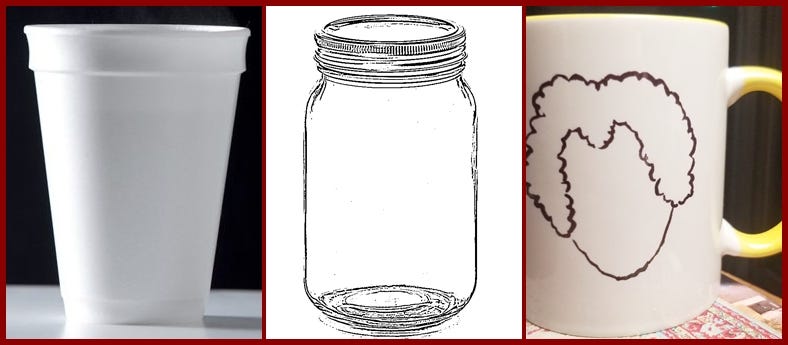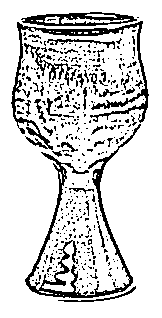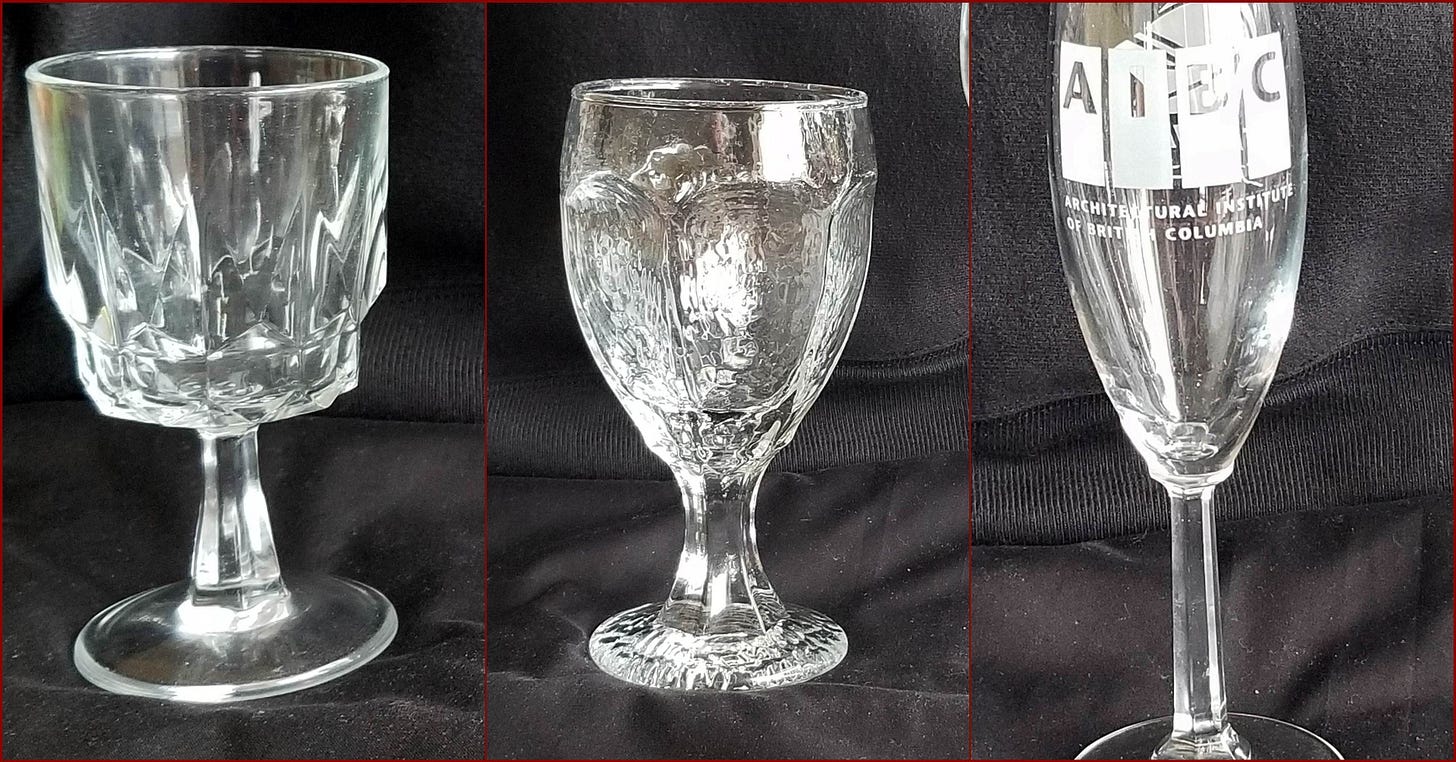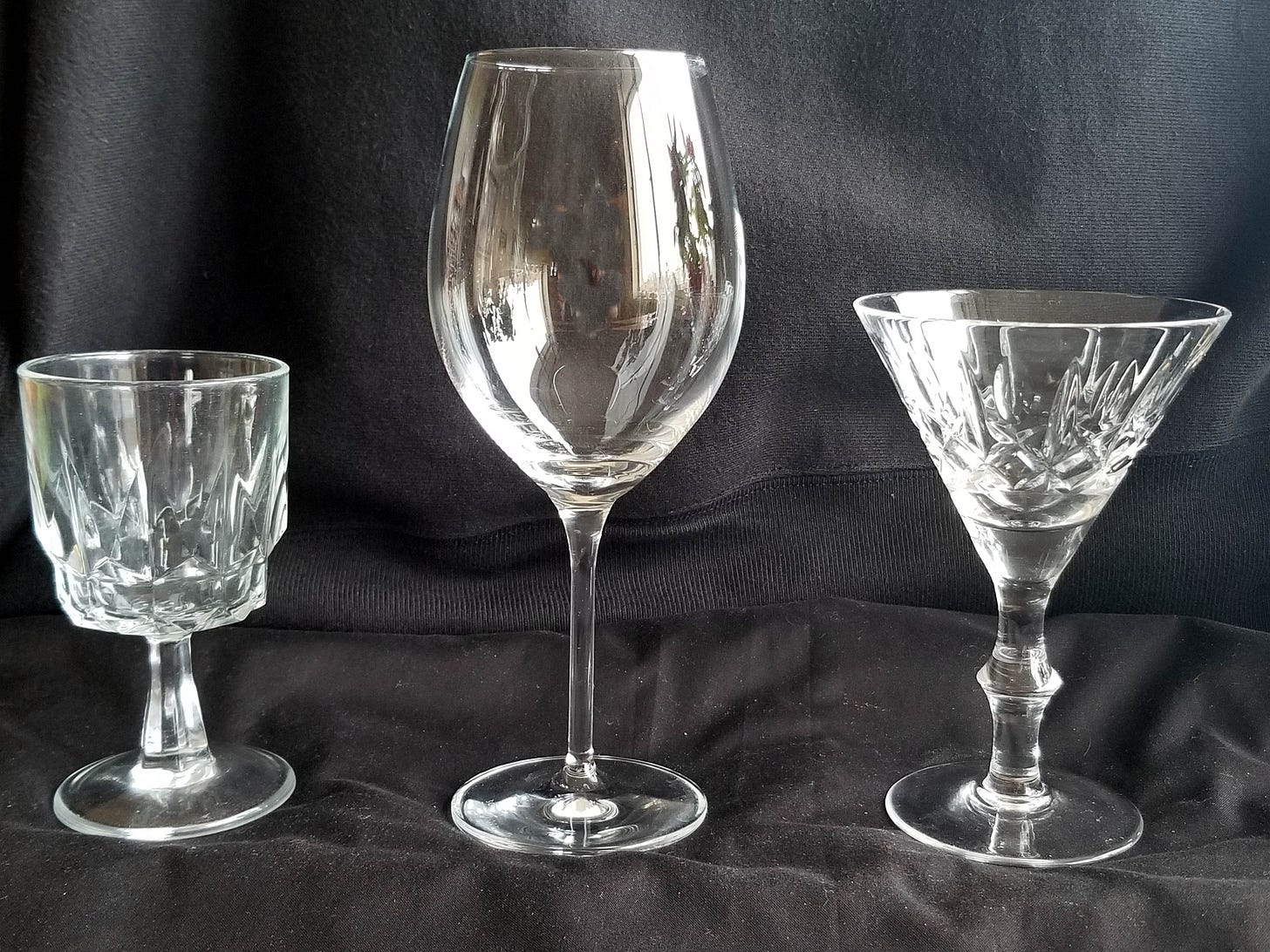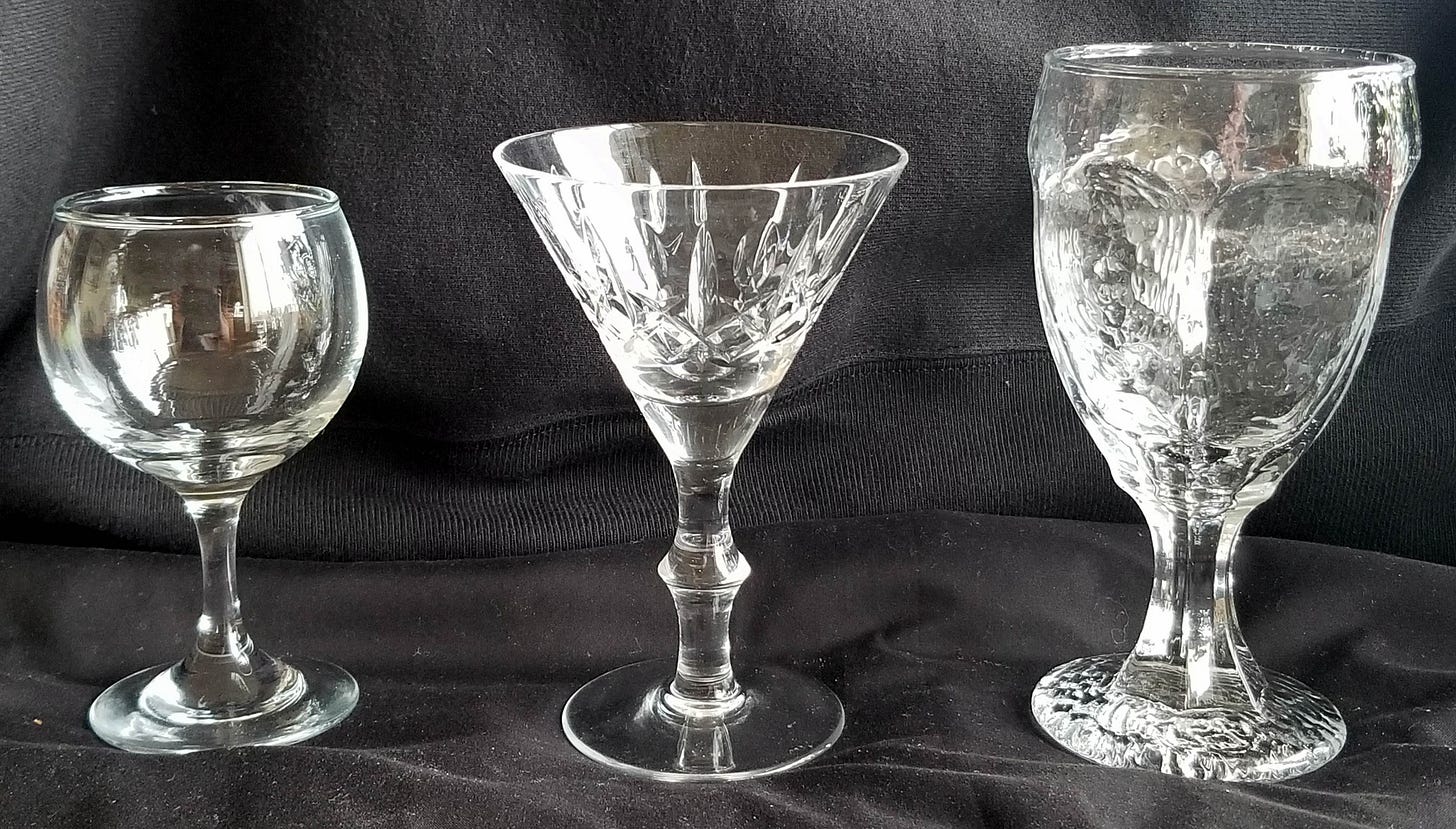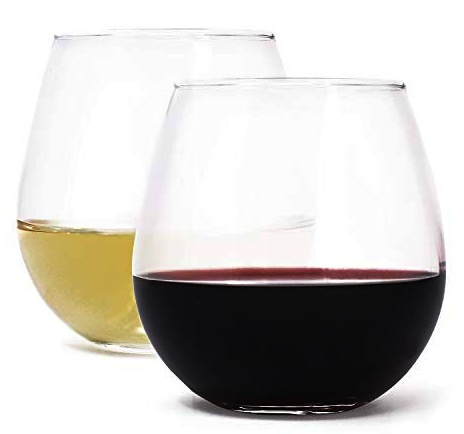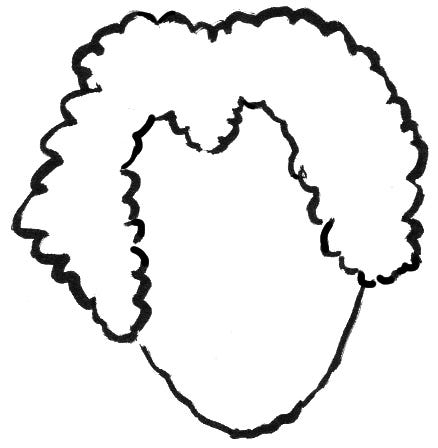Welcome to the latest edition.
Pro Tip - You May Need Glasses
Some Basic Suggestions For Your Essential Wine Utensil
“How can we know the dancer from the dance?”
The size, shape and structure of the wine glass you use is important if you are interested in the variety and delights that wine can provide. It’s not as important as the wine glass companies would like you to believe but your enjoyment of wine really depends to a certain degree, on the vessel used to get wine from the bottle to your mouth.
I’m not talking about what is the proper glass, according to some branch of wine snobbery . It’s not about that. If you simply want to sip and enjoy your wine, whatever it might be from high to low, then a mug, a mason jar or a styrofoam cup will do just fine. Enjoy wine as you see fit.
Your Wine Glass Is a Utensil
Wine is a part of gastronomy. To eat and drink, we need tools and utensils both to prepare food and to enjoy it. It just makes sense to have the right implement for the task at hand. You can’t eat spaghetti with a knife or feed yourself salad with a spoon. A good glass with the right features just works better than other choices.
There are some other aspects related to wine glasses that will be explored in future newsletters but today we will look at whether you might want to upgrade the wine glasses you have to something that works a bit (or a lot) better.
What are the features of a More Useful Wine Glass?
Here are some of the attributes for a good wine glass as well as some examples of glasses that you might want to avoid and why.
A good wine glass will show you a fuller array of the aromas and flavours present in the wine. It has a few basic elements.
Material: Clear Glass Only
It doesn’t matter whether it’s crystal or not but it does need to be clear glass. This is so that you can see the sometimes subtle range and depth of colours, traces of sediment or bubbles that might be in the wine.
On the Stone Age side, stoneware wine glasses had their moment in the 70s but seriously, using these or others that are this opaque means you may not be able to tell if a wine is red or white…
Likewise, the “translucent trio” below. Yes, you can see into the glass and tell the colour of the wine but frosted patterns, etchings, and logos mean you can’t really see the wine in a clear and unobstructed way.
Size Matters But Only to a Point
The minimum size of the wine glass is pretty important. You need one big enough so that when pouring an ounce or two of wine in the bottom, there is still a good amount of space above the wine level in the glass for the various subtle aromas to “congregate” in that space and be detected by your nose and palate. If the space in the glass above the wine is too small or the glass flares out widely, the aromas simply fan out and vanish into thin air before you can really smell them.
The Shape of Space
You’ve probably seen this illustration before - is it a cup or two faces? The “negative spaces” on the sides of the cup can also be seen as two faces.
Look in the same way at the size/shape of the space in a wine glass above the poured level of the wine. The difference in what aromas and flavours are available to you and emphasized or suppressed in various wine glasses actually relate directly to this space. Think if it as the “negative space” in the glass.
Right Sizing
In the photo below, the middle glass is a good minimum for a wine glass size and has a good shape. The other two smaller glasses are of different shapes that are not very helpful. The smaller ones will dampen down the aromas and flavours of the wine just like turning down the volume on your stereo.
The middle glass happens to be from a company called Schott-Zwiesel and is a billed as a chardonnay glass. It is 8 inches tall, 3 1/4 inches wide and holds approximately 14 ounces or 400 millilitres. Any glass around this size and shape from any manufacturer will work quite well for most dry wines red, white or rosé. It’s partly just physics. When you swirl the wine before smelling and tasting, there is bigger surface on the inside of the glass that then releases a greater volume of aromas.
Shape: Flaring Out But Gathering In
One of the successful principles of wine glass design from a tasting point of view, is when there is a flaring out to create more surface area but then a pursing in a little at the top. This gathering in definitely concentrates the aromas released when you swirl the wine before sipping. A glass that just flares, scatters the aromas into the air.
Try It Yourself
If you have a variety of different sized glasses or tumblers at home including one of the minimum suggested size, you can see for yourself the difference that glass size makes. Put an identical small amount of the same wine in each glass (1 to 2 ounces) and then start tasting backwards. That is, start by smelling and tasting in the bigger glass and then work your way down to the smaller one. I recently did this with my friends Ann and Barry and we were amazed to find that in the smallest one (about 4 ounces) we couldn’t detect anything at all. It was like smelling water.
This does not mean that the bigger the glass the better though. True to a point but there is a limit.
A glass that is big enough to serve as a tiny home for a goldfish does not necessarily improve things.
I have held $100.00 crystal glasses that could contain more than an entire bottle of wine. They were grand, I guess, but in fact past a certain point greater size has the opposite effect and diminishes aromas and flavours. There is a right size range for wine glasses.
Stems - The “hand” in Handle
The stem is the handle of your wine glass, just as you have one on a knife, fork or spoon. If you are looking to buy new wine glasses, don’t overlook getting a glass that fits your hand. The stem should be long enough and thin enough to accommodate your hand comfortably. Short stems can make your hand feel pinched and crowded.
When looking at wine glasses, pick them up and heft them, place them down, see how they feel in your hand. A good glass will feel balanced and easy.
Also, thick glass serves no purpose and feels heavy and awkward. So these three, not so much…
Go Stemless?
Stemless wine glasses have gained popularity in recent years, perhaps because they seem less pretentious and more casual. I get that and again, if you aren’t interested in exploring wine, are on your boat or simply want enjoy your wine, without contemplating it, by all means do so.
But if you do want to find out more about the mysteries and pleasures of wine, Stemless glasses do have some disadvantages.
First of all, look at it.
It’s a tumbler.
So if you grab a tumbler of wine, your fingerprints will soon be all over it, making it messy looking and more difficult to see the wine.
Secondly, holding the tumbler in your hand is going to warm up the wine more quickly than just sitting in the air. Wine has a wider operating-temperature-range-of-pleasure than some wine authorities might have you believe but if you do warm that white wine from well chilled to room temperature, it is going to change and lose a lot of its charm.
Red wines are similarly affected. If they get too warm, the aromas and flavours start to shift, warp and then head for the exit. It’s not a disaster, you will still enjoy the wine but you do lose a lot of the pleasure and genuine interest that the wine might have been able to show you.
Lastly, part of the purpose of a stem is to keep your hands and any lingering odours they may have, (say from chopping that garlic before dinner, using soap etc.) away from the wine, it’s aromas and your nose.
Base
Pay some attention to the size of the base. It should be in keeping with the size and width of the bowl above it. Generally the base width should be a bit smaller than the widest part of the bowl. Too small and the glass might be tippy, especially with wine in it and too large can make it clunky and awkward to place down.
Tips on Buying Wine Glasses
Using the “prescription” above, if you feel you do need to buy new glasses here are a few suggestions:
You don’t need to buy crystal wine glasses. Avoid the thrift stores but a big box or department store (or their web site) that specializes in housewares is a good place to start. Just pay attention to the volume of the glass, say 13 oz. to 17 oz. (385 ml. to 500 ml.) and it’s basic height, width and shape. If you search online, you should be able to find something in non-crystal for between $5.00 to $10.00 per glass. Basic crystal wine glasses need not be that much more either. Just search and compare.
Buy a few more glasses than you think you will need. If for example you feel you need 6, get 8 or maybe even twice as many. You or your guests are going to break some eventually (it’s the fate of wine glasses) so it’s good to have matching spares or enough for larger dinners, side by side tastings or parties.
Make room in the front of your kitchen or dining room cabinets for the new wine glasses and use them all the time, not just for special occasions. If you are drinking wine with interest, why not use the best utensil you have?
Unless you have some sentimental attachment to any small, stubby, heavy cut, flaring out wine glasses you may own, get rid of them. No wait.. save a few so that you can show the backwards glass wine comparison to interested friends or guests. Knowledge is for sharing.
Until next time.






